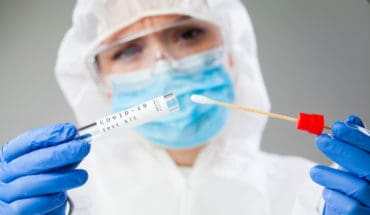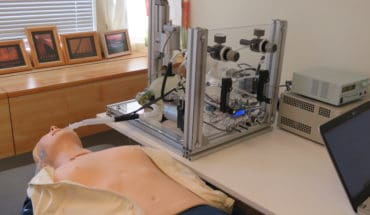August is Psoriasis awareness month. What is psoriasis? Psoriasis is a non-contagious, chronic autoimmune disease that causes skin inflammation, and is linked to other autoimmune deficiencies such as psoriatic arthritis.
Proriasis Awareness month and is used as an opportunity to educate and inform sufferers on a range of topics varying from treatment, causes, triggers and management of the inflammatory and often irritating disease.
The cause of psoriasis is still unknown but specialists do know that it is largely affected by the immune system and genetics.
Transcript
Psoriasis is a non-contagious, chronic autoimmune disease that causes skin inflammation, and is linked to other autoimmune deficiencies such as psoriatic arthritis. It can be incredibly itchy and form silver plaques on the skin that can be embarrassing, and have both physical and psychological effects.
Afflicted reality TV star Kim Kardashian, and singer Cyndi Lauper have each spoken out on how psoriasis can have a significantly negative impact on the quality of life.
Normally, the skin is divided into three layers–the epidermis, dermis, and hypodermis. The hypodermis is made of fat and connective tissue that anchors the skin to the underlying muscle. Just above the hypodermis is the dermis, which contains nerves, sweat glands, lymph and blood vessels.
Just above the dermis is the epidermis. The epidermis itself has multiple cell layers that are composed of developing keratinocytes – which are named for the keratin protein that they’re filled with. Keratin is a strong, fibrous protein that allows keratinocytes to protect themselves from getting destroyed when you rub your hands through the sand at the beach.
Keratinocytes start their life at the lowest layer of the epidermis called the stratum basale, or basal layer, which is made of a single layer of small, cuboidal to low columnar stem cells that continually divide and produce new keratinocytes. These new keratinocytes migrate upwards, forming the other layers of the epidermis.
As keratinocytes in the stratum basale begin to mature and lose the ability to divide, they migrate into the next layer, called the stratum spinosum which is about 8 to 10 cell layers thick. The stratum spinosum also has dendritic cells lurking around, which are star-shaped immune cells constantly patrolling for invading microbes as part of the body’s immune defense system.
The next layer up is the stratum granulosum which is 3 to 5 cell layers thick. Keratinocytes in this layer begin the process of keratinization, which is the process where the keratinocytes flatten out, and get rid of their intracellular structures and die, and in the process they create the epidermal skin barrier.
Keratinization leads to development of the stratum lucidum layer which is 2 to 3 cell layers thick of translucent, dead keratinocytes that have shed nuclei. The stratum lucidum is only found in thick skin like on the palms and soles of the feet, because those are the areas that need extra protection. The stratum lucidum is absent in thin skin, which covers the rest of the body, and the other layers are thinner.
Finally, there’s the stratum corneum, or the uppermost and thickest layer of the epidermis, which is like a wall of 20-30 layers. As new keratinocytes push up into the stratum corneum, older dead cells are sloughed off forming skin flakes or dandruff.
In this way, the thickness of the epithelium remains constant with a regulated turn-over of keratinocytes. Normally, there are microbes that live on the surface of the skin, but when there’s a tiny break in the skin or cut, those microbes have the ability to enter into the skin layer. At that point, the body notices these ‘foreign invaders’ and immune cells called dendritic cells capture foreign antigens, break them down into little fragments that they then present to T-cells.
There are two different types of T Cells, cytotoxic T Cells, which directly kill infected cells, and helper T cells, that help to facilitate the overall immune response. So, if the dendritic cells present these fragments and the fragments are recognized by the T-cell, then the T-cell releases cytokines. Cytokines are small proteins used in cell signaling – such as IL-12, IL- 23, interferon-γ, tumor necrosis factor or TNF, and IL-17, which specifically has been linked to chronic inflammation.
This entire process of inflammation increases keratinocyte proliferation in the skin. This also recruits other immune cells, like neutrophils, to the site of infection. Once the microbe is completely destroyed, the immunologic response slowly returns back to normal.
In psoriasis, this immunologic response is abnormal, and it leads to excessive inflammation. You can think of it as an over-amplification of the skin’s natural immune process that goes a bit haywire. The causes of psoriasis aren’t clear but there’s definitely a genetic component and environmental triggers, like trauma, stress, dietary factors, smoking, or a previous infection.
Regardless of how the process is triggered, once it’s underway it doesn’t shut off, resulting in chronic damage to the skin. In the dermis, inflammation causes the blood vessels to dilate, particularly at the border between the dermis and epidermis.
This allows vessels to circulate and deliver more immune cells, particularly neutrophils, to the epidermis. In the epidermis, neutrophils collect in the stratum corneum layer.
The inflammation also causes keratinocytes to proliferate excessively and mature abnormally. The increased keratinocyte proliferation thins out the stratum basale; but thickens the other layers, particularly the stratum corneum and stratum spinosum.
In fact, as keratinocyte growth outpaces sloughing off, the cells begin to pile up. These proliferating keratinocytes have a few maturation defects which are most obvious in the stratum corneum.
- First, the keratinocytes produce more keratin than usual causing this layer to become even thicker.
- Second, the keratinocytes retain their nuclei – which is called parakeratosis.
- Third, the keratinocytes don’t adhere to each other properly, causing breaks in the epidermis. That weakens the skin and makes it more susceptible to bacteria and viruses, and also gives the skin a scaly appearance. If scales are picked off, the blood vessels in the dermis can get injured, causing localized spots of bleeding, called an Auspitz sign.
Symptoms of psoriasis can vary, and there are a few subtypes.
- Plaque psoriasis is the most common. It appears as flattened areas of epidermal elevation that are inflamed and red or salmon-colored, from the underlying dilated blood vessels, and are topped with white-silvery scales. Plaques are typically itchy and found on the scalp and in tensor regions, like the elbows, groin, lower back, and knees.
- Guttate psoriasis appears as small, red, individual spots on the trunk and limbs. This subset usually starts in childhood, and is sometimes triggered by an infection, like a strep throat.
- Inverse psoriasis appears as smooth and shiny red lesions that lack scales and typically form within skin folds like in the genital region, under arms or under the breasts.
- Pustular psoriasis appears as areas of red skin with small, white elevations of cloudy pus, formed from dead immune cells. They are usually tender and form on the hands and feet.
- Erythrodermic psoriasis is usually the most severe subset, and appears as fire-red scales that can cover a large area of the skin. They are often extremely itchy and painful and fall off in large sheets.
- Psoriatic arthritis manifests as inflammation in the joints. Nail pitting, shallow or deep holes in the nails, may appear in any subset.
The diagnosis is typically based on the distribution of the skin damage, and a tissue biopsy can be done to confirm the diagnosis by looking for classic changes in the epidermal layers.
Treatment for psoriasis can include:
- Moisturizers and emollients to help clear psoriatic plaques and minimize itchiness, or may require topical or systemic immunosuppressive therapies to dampen the immune response.
- UV phototherapy can also be an option to induce DNA damage in the keratinocytes and halt their proliferation.
- New research has been targeting stress management, dietary intervention, and other immunotherapies to decrease whole body inflammation.
For some individuals, there can be significant feelings of depression or anxiety, especially when there are areas of skin affected by severe psoriasis. Psychological counselling can help suffers cope with their condition. In fact, there’s a field called psychodermatology which utilizes strategies like anti-anxiety medications, biofeedback, allergy and immune function testing, as well as cognitive behavioral therapy.
OK, so, to recap:
- Psoriasis is an autoimmune disease that leads to chronic changes in the epidermis due to overstimulation of immune cells and excessive proliferation of keratinocytes that don’t mature correctly.
- Psoriasis most commonly causes silvery scaling of the skin and itchiness.
- The diagnosis can be made visually, or with a tissue biopsy.
- There are various oral and topical treatment options available, as well as new areas of lifestyle and dietary intervention, and psychodermatology which addresses the relationship between emotionsand physical changesin the skin.
- Early onset dementia more common than previously reported - 26th July 2024
- Children’s Exposome Linked to Serum Metabolite Changes - 24th July 2024
- Is Melatonin the wonder drug of anti-aging? - 22nd July 2024





